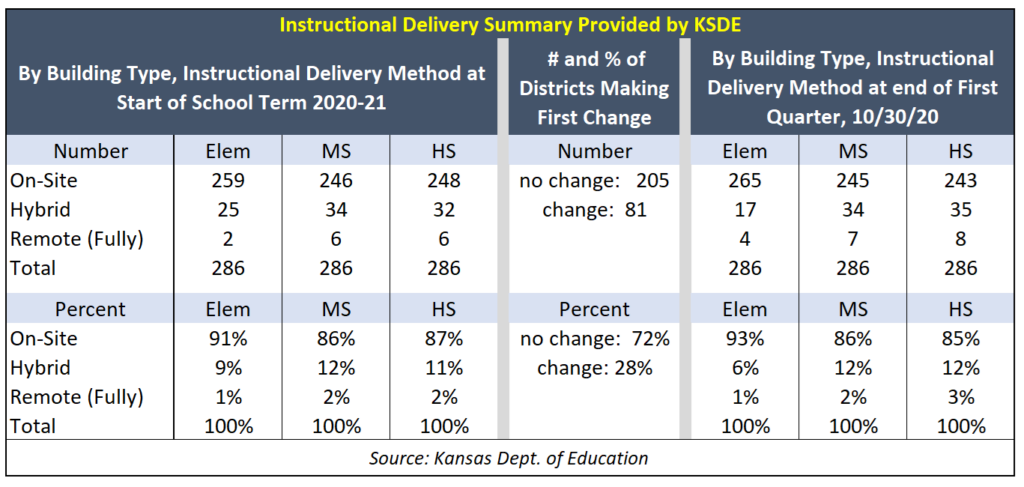The Center for Disease Control and the Kansas State Department of Education issued new, stringent school opening guidance week, but some worry the guidelines may do just the opposite: shutter schools already open and keep chains on school buildings that remain closed.
The Kansas State Board of Education adopted the new school opening guidance last week. It recommends remote-only learning for middle and high school students if school districts can’t meet several metrics. The metrics include masking, maintaining 6-feet of distance, ventilation guidelines, handwashing recommendations, and frequent testing for staff and students involved in certain activities.
Michelle Dombrosky, a state board of education member, voted ‘present’ on the updated guidelines.
“Every time we meet, we add one more barrier to opening,” Dombrosky said. “Social distancing. Hand washing. Testing. Some of these schools are going to follow this by the book.”
That means many won’t open for full-time, in-person learning, she said.
The state guidance, called Navigation Next, includes recommendations for how the schools should use federal funding they receive for pandemic response. For instance, it recommends using funding for social and emotional services. It doesn’t require that schools open for in-person learning in order to draw the funding.
“It doesn’t give me as a parent an assurance or hope in my district that things are going to change anytime soon,” she said. “…I see more things rolled out for social and emotional services. If we just get the kids back in the classroom, it will fix a lot of these things.”
Many of the state education department’s guidelines mirror the CDC guidance issued February 12.
The CDC report uses a variety of metrics for determining whether schools should open, including the rate of COVID spread in a community, routine testing, and the ability of schools to maintain 6-feet of social distancing in classrooms.
CDC school opening guidance should serve as ‘wake-up call’
In a guest column for the Washington Post, Joseph G. Allen, a Harvard professor at the T.H. Chan School of Public Health, and Helen Jenkins, a professor at Boston University, wrote the CDC report should be a “wake-up call” to parents.
“If they’re not back already, your kids are not going back to school full-time this year,” they write.
The state recommendations include requiring staff to be tested twice weekly. It suggests students involved in extracurricular activities should be tested twice per week, and students who work should be tested at least once per week. The CDC school opening guidance also suggests implementing testing programs. Even with CDC-recommended protocols, middle and high school students would remain in hybrid learning modes if community spread remains high.
“So if a school did take on screening testing, all that would get them is moving middle and high schools into a hybrid mode. That’s a big lift for not much gain toward reopening,” Allen and Jenkins write.
The CDC uses four color-coded levels to define community spread. Blue is low, yellow is moderate, orange is substantial, and red is high. Schools in the blue zone have a rolling 7-day average of fewer than 9 cases per day per 100,000 people. In the red zone, middle schools and high schools that can’t maintain 6-feet of social distancing and without stringent testing protocols are remote.
“The thresholds for these metrics are also very low. Communities only get into the blue zone if they report about one daily case per 100,000,” writes Allen and Jenkins. “Good luck to any districts hoping to get to that level before most people are vaccinated.”
When districts finally reach those thresholds, the CDC recommends the low levels should be documented “continuously for several weeks,” before schools reopen.
The goalposts keep moving
Statewide, the rolling 7-day average of Kansas cases is 22 per 100,000. That’s yellow, per the CDC recommendations. In some rural Kansas counties, as few as 1 case per day, or a family of four testing positive, could result in shuttering school buildings for weeks or months.
Allen and Jenkins also believe the six-foot guidance also serves to keep schools closed.
“This six-foot distancing rule is what will keep most kids out of school simply because of space limitations,” they write.
It could lead to open schools deciding to close. University of Chicago Laboratory Schools, a K-12 program, scaled back its reopening as a result of the CDC recommendations. In a letter to parents issued Feb. 16, the interim director announced kids in grades 3-5 now will do hybrid rather than in-person learning. Its initial plans spaced kids at 5-feet apart — one-foot shy of the CDC recommendations.
Dombrosky said everyone keeps saying they want to open schools, but the goalposts keep moving.
“We’re not seeing a light at the end of the tunnel. We keep adding barriers and we just keep seeing more goal posts,” she said.
Parents are pleading in school board meetings and to the Kansas Legislature for a return to in-person learning. Often, their appeals fall on deaf ears. However, Kansas Senate President Ty Masterson introduced legislation last week mandating schools reopen by March 26. It’s scheduled for a hearing next week.
“Kansas parents have been patient, but they have seen their children struggling and they have had enough. It’s time to do what is desperately needed and get Kansas kids back to school,” Masterson said in a press release.
The Kansas Association of School Boards and the Kansas National Educators Association, a teacher’s union, are likely to oppose the bill. A lobbyist for the union told the Associated Press that “returning to in-person instruction in a time of pandemic should happen when it is safe to do so according to the medical experts.”
“That has been our position all along and that will continue to be our position,” Marcus Batzell, director of communications for the KNEA said.
White House school goals shifting
As recently as December, President Joe Biden said schools reopening was a national priority for his first 100 days in office.
“If states and cities put strong public health measures in place that we all follow, then my team will work to see that a majority of our schools can be open by the end of my first 100 days,” then-President-elect Biden said in early December.
His press secretary Jen Psaki, however, clarified last week the administration’s goal is for more than 50% of schools to have “some teaching in person at least one day a week,” by day 100. At a town hall on Tuesday, Biden said the goal is five days per week for students in elementary and middle school.
“I think that we’ll be close to that by the end of the first 100 days. You’ll have a significant percentage of them being able to open. My guess is they’re going to be pushing to open all summer, to continue like it’s a different semester,” Biden said. “The goal will be five days a week.”
Most Kansas school districts have been open for in-person learning, but for students in many of the state’s largest districts, classrooms remain closed — or only partially open. And in some, like the Kansas City, Kansas, School District, there are no plans for full-time, in-person learning. KCK will bring students into buildings this month, but only students with connectivity issues. Technology staff will assist those students in district buildings, while they learn from teachers offering lessons from remote locations.

Dave Trabert, CEO of Kansas Policy Institute, says Kansas schools should learn from experience.
“Our experience here in Kansas shows about 250 school districts did open safely without any problems,” he said. “Daycare centers are open. In fact, they’ve been open the entire time. All around schools are opening without incidence. This (state board of education) is a political decision. Keeping schools closed has nothing to do with education or health or science. It’s politics.”



